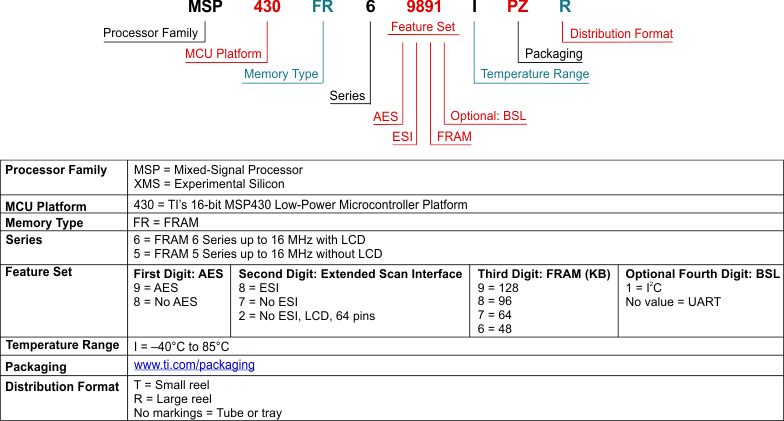JAJSG20C August 2014 – August 2018 MSP430FR6877 , MSP430FR6879 , MSP430FR68791
PRODUCTION DATA.
- 1デバイスの概要
- 2改訂履歴
- 3Device Comparison
- 4Terminal Configuration and Functions
-
5Specifications
- 5.1 Absolute Maximum Ratings
- 5.2 ESD Ratings
- 5.3 Recommended Operating Conditions
- 5.4 Active Mode Supply Current Into VCC Excluding External Current
- 5.5 Typical Characteristics, Active Mode Supply Currents
- 5.6 Low-Power Mode (LPM0, LPM1) Supply Currents Into VCC Excluding External Current
- 5.7 Low-Power Mode (LPM2, LPM3, LPM4) Supply Currents (Into VCC) Excluding External Current
- 5.8 Low-Power Mode With LCD Supply Currents (Into VCC) Excluding External Current
- 5.9 Low-Power Mode LPMx.5 Supply Currents (Into VCC) Excluding External Current
- 5.10 Typical Characteristics, Low-Power Mode Supply Currents
- 5.11 Typical Characteristics, Current Consumption per Module
- 5.12 Thermal Resistance Characteristics
- 5.13
Timing and Switching Characteristics
- 5.13.1 Power Supply Sequencing
- 5.13.2 Reset Timing
- 5.13.3 Clock Specifications
- 5.13.4 Wake-up Characteristics
- 5.13.5
Peripherals
- 5.13.5.1 Digital I/Os
- 5.13.5.2 Timer_A and Timer_B
- 5.13.5.3 eUSCI
- 5.13.5.4 LCD Controller
- 5.13.5.5
ADC
- Table 5-24 12-Bit ADC, Power Supply and Input Range Conditions
- Table 5-25 12-Bit ADC, Timing Parameters
- Table 5-26 12-Bit ADC, Linearity Parameters With External Reference
- Table 5-27 12-Bit ADC, Dynamic Performance for Differential Inputs With External Reference
- Table 5-28 12-Bit ADC, Dynamic Performance for Differential Inputs With Internal Reference
- Table 5-29 12-Bit ADC, Dynamic Performance for Single-Ended Inputs With External Reference
- Table 5-30 12-Bit ADC, Dynamic Performance for Single-Ended Inputs With Internal Reference
- Table 5-31 12-Bit ADC, Dynamic Performance With 32.768-kHz Clock
- Table 5-32 12-Bit ADC, Temperature Sensor and Built-In V1/2
- Table 5-33 12-Bit ADC, External Reference
- 5.13.5.6 Reference
- 5.13.5.7 Comparator
- 5.13.5.8 FRAM Controller
- 5.13.6 Emulation and Debug
-
6Detailed Description
- 6.1 Overview
- 6.2 CPU
- 6.3 Operating Modes
- 6.4 Interrupt Vector Table and Signatures
- 6.5 Bootloader (BSL)
- 6.6 JTAG Operation
- 6.7 FRAM
- 6.8 RAM
- 6.9 Tiny RAM
- 6.10 Memory Protection Unit Including IP Encapsulation
- 6.11
Peripherals
- 6.11.1 Digital I/O
- 6.11.2 Oscillator and Clock System (CS)
- 6.11.3 Power-Management Module (PMM)
- 6.11.4 Hardware Multiplier (MPY)
- 6.11.5 Real-Time Clock (RTC_C)
- 6.11.6 Watchdog Timer (WDT_A)
- 6.11.7 System Module (SYS)
- 6.11.8 DMA Controller
- 6.11.9 Enhanced Universal Serial Communication Interface (eUSCI)
- 6.11.10 Timer_A TA0, Timer_A TA1
- 6.11.11 Timer_A TA2
- 6.11.12 Timer_A TA3
- 6.11.13 Timer_B TB0
- 6.11.14 ADC12_B
- 6.11.15 Comparator_E
- 6.11.16 CRC16
- 6.11.17 CRC32
- 6.11.18 True Random Seed
- 6.11.19 Shared Reference (REF_A)
- 6.11.20 LCD_C
- 6.11.21 Embedded Emulation
- 6.11.22
Input/Output Diagrams
- 6.11.22.1 Digital I/O Functionality – Ports P1 to P10
- 6.11.22.2 Capacitive Touch Functionality Ports P1 to P10 and PJ
- 6.11.22.3 Port P1 (P1.0 to P1.3) Input/Output With Schmitt Trigger
- 6.11.22.4 Port P1 (P1.4 to P1.7) Input/Output With Schmitt Trigger
- 6.11.22.5 Port P2 (P2.0 to P2.3) Input/Output With Schmitt Trigger
- 6.11.22.6 Port P2 (P2.4 to P2.7) Input/Output With Schmitt Trigger
- 6.11.22.7 Port P3 (P3.0 to P3.7) Input/Output With Schmitt Trigger
- 6.11.22.8 Port P4 (P4.0 to P4.7) Input/Output With Schmitt Trigger
- 6.11.22.9 Port P5 (P5.0 to P5.7) Input/Output With Schmitt Trigger
- 6.11.22.10 Port P6 (P6.0 to P6.6) Input/Output With Schmitt Trigger
- 6.11.22.11 Port P6 (P6.7) Input/Output With Schmitt Trigger
- 6.11.22.12 Port P7 (P7.0 to P7.7) Input/Output With Schmitt Trigger
- 6.11.22.13 Port P8 (P8.0 to P8.3) Input/Output With Schmitt Trigger
- 6.11.22.14 Port P8 (P8.4 to P8.7) Input/Output With Schmitt Trigger
- 6.11.22.15 Port P9 (P9.0 to P9.3) Input/Output With Schmitt Trigger
- 6.11.22.16 Port P9 (P9.4 to P9.7) Input/Output With Schmitt Trigger
- 6.11.22.17 Port P10 (P10.0 to P10.2) Input/Output With Schmitt Trigger
- 6.11.22.18 Port PJ (PJ.4 and PJ.5) Input/Output With Schmitt Trigger
- 6.11.22.19 Port PJ (PJ.6 and PJ.7) Input/Output With Schmitt Trigger
- 6.11.22.20 Port PJ (PJ.0 to PJ.3) JTAG Pins TDO, TMS, TCK, TDI/TCLK, Input/Output With Schmitt Trigger
- 6.12 Device Descriptors (TLV)
- 6.13 Memory
- 6.14 Identification
- 7Applications, Implementation, and Layout
- 8デバイスおよびドキュメントのサポート
- 9メカニカル、パッケージ、および注文情報
パッケージ・オプション
メカニカル・データ(パッケージ|ピン)
サーマルパッド・メカニカル・データ
- PZ|100
発注情報
8.2 デバイスの項目表記
製品開発サイクルの段階を示すために、TIではMSP MCUデバイスのすべての型番に接頭辞が割り当てられています。MSP MCU商用ファミリの各番号には、MSP、XMSのいずれかの接頭辞があります。これらの接頭辞は、製品開発の進展段階を表します。段階には、エンジニアリング・プロトタイプ(XMS)から、完全認定済みの量産デバイス(MSP)までがあります。
XMS - 実験段階のデバイスで、最終的なデバイスの電気的仕様を表しているとは限りません。
MSP - 完全に認定済みの量産版デバイスです。
XMSデバイスは、次の免責事項付きで出荷されます。
「開発中の製品は、社内での評価用です。」
MSPデバイスの特性は完全に明確化されており、デバイスの品質と信頼性が十分に示されています。TIの標準保証が適用されます。
プロトタイプ・デバイス(XMS)は標準の量産デバイスよりも故障率が高いことが予想されます。これらのデバイスは、予測される最終使用時の故障率が未定義であるため、TIはそれらのデバイスを量産システムで使用しないよう推奨しています。認定された量産デバイスのみを使用する必要があります。
TIデバイスの項目表記には、デバイス・ファミリ名の接尾辞も含まれます。この接尾辞は、温度範囲、パッケージ・タイプ、配布形式を示しています。デバイス名の各部の読み方をFigure 8-1に示します。

A.
Figure 8-1 デバイスの項目表記 - 型番の読み方 NOTE:
この図は、利用可能な機能とオプションの完全なリストではなく、与えられたデバイスまたはファミリについて、これらの機能とオプションのすべてが利用できることを示すものでもありません。